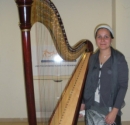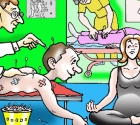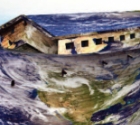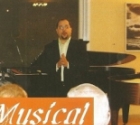
As told to Herb Hahn. Photo by Gali Hermon
After 25 years as one of Israel’s well known fashion, movie and sport journalists working for Yediot Aharonot, La-Isha, AT, Davar, The Jerusalem Post and London’s Jewish Chronicle, Sandra Skarbek gave it all up to go back to her roots as a painter.
Born in 1941 wartime England, Skarbek was educated at Saint Martins School of Art in London (one of her college mates was the Israeli artist Kadishman). Sandra later studied at the Collegio des Bellas Artes in Caracas, Venezuela, where she lived for many years with her family, and worked as an illustrator for the Caracas Daily Journal.
When she was 26, Sandra returned to London. She looked for but could not find work. It was then, during Israel’s Six Day War, that Sandra decided to get into the action and walked into the Jewish Agency headquarters and stated her case. “I am young, willing and able” I told the woman at the front desk, “as long as I will not be in danger and I can paint.” Thus Sandra got to Israel on May 14, 1968, “and here I live to this day.”
“I lugged my portfolio around Tel Aviv. I drew catalogs for Polgat, did press releases for Gottex, wrote my first article for Tommy Lapid’s magazine, AT, called An English Alice In The Israeli Wonderland, and finally landed a job as fashion writer with Yediot Aharanot newspaper. My favorite story while at Yediot was going to London to have a three hour interview with England’s World Cup winning team captain Bobby Moore and striker Geoff Hurst. I still think it was the best thing I did. I also interviewed Ian McKellen ( before he became a “sir”.) Besides fashion and sports, I worked on movies, TV, beauty and gossip.
“I met and married Moshe Shindler in 1972. But unlike the story I wrote For Tommy Lapid’s AT magazine about my wanting to have a family of six little girls, we were unable to have any children. I was now at La-isha, successful and in my fifties. Due to a contract dispute we had a parting of the ways. Moshe and I moved from Tel Aviv to Kfar Saba. A year later my mother died. I was unable to find work. No one in the business would hire me. In 1998, just past his 51st birthday, Moshe died, far too young, of lung cancer. After his death, work would have been the best medicine for this grieving widow. Moshe had died so suddenly – I couldn’t come to grips with it. I had no work, no friends. All the family that mattered to me were gone. And so I drank – and drank – and drank and wanted to die – and took more pills. The girl who had everything had become an old woman with nothing to live for. And then my fingers itched to hold a paint brush again.
“Slowly, I began with tempera, then added pastel, then watercolor and finally I began to paint in oil. Oh, I still drink – it helped the painting. I painted women, children, horses, landscapes, nudes, gardens and a special group on the Holocaust where many of my father’s Polish family perished.
“What I care about is that I can paint. And to a degree they sell. As long as they go to a good home I am pleased. It means I must have some talent after all. People say my paintings are alive and bursting with color.
“No, I’m not famous anymore but I have great satisfaction from my work. My paintings are my children, my own creation and to see them leave me and go out into the world makes me cry and laugh at the same time. If they please other people I am glad. I’ll never be rich again and
my nervous depression, agoraphobia and my hand always reaching for a glass with something stronger than water in it, will never go away.
My need to be looked after by Mummy and Moshe will also not go. But here in the Shomron people are kind to me. I am alone, yet not alone. And I shall have at last started the rebirth of Sandra the artist in her Israeli Wonderland.”
Visitors are welcome to her studio from 12 noon to 12 midnight. Enquiries: 09 766 6321
Herb Hahn spent 36 years in advertising in the U.S. before he retired as Vice President of sales for a leading radio station rep firm. He came out of retirement two more times to sell advertising research and then direct mail advertising before he made aliyah four years ago. He is the creator of Yiddish Ta'am, a program of Jewish nostalgia, music and stories. He enjoys performing for ESRA audiences.
 DEAR EDITOR 155
DEAR EDITOR 155 MODIIN ON THE MOVE
MODIIN ON THE MOVE HEALTH HINTS ONIONS FOR JAUNDICE
HEALTH HINTS ONIONS FOR JAUNDICE Art from the Heart
Art from the Heart Jewish Art Returns to Jerusalem
Jewish Art Returns to Jerusalem Musical Treats
Musical Treats